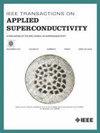了解带条纹 REBCO 股的 Roebel 电缆的磁化损耗
IF 1.7
3区 物理与天体物理
Q3 ENGINEERING, ELECTRICAL & ELECTRONIC
引用次数: 0
摘要
大电流超导电缆对于过去和未来的加速器和核聚变磁体至关重要。用于大型强子对撞机和热核聚变实验堆(ITER)的低温超导(LTS)电缆之所以取得成功,归功于通过采用绞合细丝有效地将 LTS 导线中的磁化率降至最低。与此相反,REBCO 磁带的磁化在罗贝尔电缆的组装股和扭曲堆叠电缆中仍然非常明显。由于绞线组装和/或扭转的三维性质,磁化损耗的定量细节尚未得到充分阐述。虽然已经对罗贝尔电缆进行了全三维建模,但由于其相互影响的复杂性,对损耗成分的分离并不那么直接。通过使用基于概念推理的简化一维模型,我们之前的研究表明:(a) 具有临界电流 $I_{c}$ 的 $(2m+1)$ REBCO 股的 Roebel 电缆本质上是两个并排的 $m$ 换股叠层,每个叠层实际上是一个 $\sim m\times I_{c}$ 的单个 Norris' 带,但也通过中间狭窄间隙中的强退磁效应与另一个磁耦合、(b) 只有在从一个叠层到另一个叠层的换位 "飞行 "中,单股才能完全解耦成独立的磁带。因此,诺里斯磁条的磁化可以直接扩展到以简单代数形式进行损耗计算,从而与实验结果达到令人满意的一致。另一方面,在带有条纹 REBCO 的 Roebel 电缆上测量到的交流损耗表现出显著差异,这一点尚待充分理解。通过定性论证、一维分析结果和数值建模,这项研究表明,条纹股中的 "细丝 "也是磁耦合的,因此其行为与诺里斯条纹的一组孤立细丝有很大不同。然后,它解释了在组装成 Roebel 电缆时,条纹股之间的微小随机错位会显著改变叠层内的磁耦合,并导致实验中观察到的交流损耗行为。本文章由计算机程序翻译,如有差异,请以英文原文为准。
Understanding Magnetization Losses of Roebel Cables With Striated REBCO Strands
High current superconducting cables are essential for past and future accelerator and fusion magnets. The low temperature superconducting (LTS) cables for the LHC and ITER machine owe their success to the effective minimisation of the magnetisation in the LTS wires by incorporating twisted fine filaments. In contrast, the magnetisation of REBCO tapes remains significant in assembled strands of Roebel cables and twisted stacks cables. The quantitative details the magnetisation loss have not been sufficiently elaborated due the 3D nature of the strand assembling and/or twisting. Although full 3D modeling of Roebel cables has been made, the separation of loss components is less straightforward due to the complexity of their interplay. By using simplified 1D models based on conceptual reasoning, it was shown in our previous studies that (a) Roebel cables with $(2m+1)$ $I_{c}$ $m$ $\sim m\times I_{c}$ striated REBCO exhibited significant differences which are yet to be fully understood. Using qualitative arguments together with 1D analytical results as well as numerical modeling, this work show the “filaments” in a striated strand are also magnetically coupled hence behave considerably differently from a set of isolated filaments of Norris' strips. It then explains that small random misalignments among the striated strands when assembled into a Roebel cable would alter significantly the magnetic coupling within the stacks and result in the ac loss behaviour observed in experiments.
求助全文
通过发布文献求助,成功后即可免费获取论文全文。
去求助
来源期刊

IEEE Transactions on Applied Superconductivity
工程技术-工程:电子与电气
CiteScore
3.50
自引率
33.30%
发文量
650
审稿时长
2.3 months
期刊介绍:
IEEE Transactions on Applied Superconductivity (TAS) contains articles on the applications of superconductivity and other relevant technology. Electronic applications include analog and digital circuits employing thin films and active devices such as Josephson junctions. Large scale applications include magnets for power applications such as motors and generators, for magnetic resonance, for accelerators, and cable applications such as power transmission.
 求助内容:
求助内容: 应助结果提醒方式:
应助结果提醒方式:


